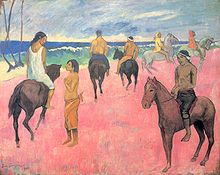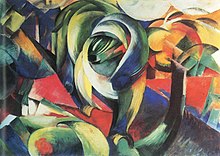Harry Fischer List

The Harry Fischer List is an inventory of works of art confiscated from German museums and art collections by the National Socialists, which fell under the category of “ degenerate art ” in the sense of National Socialite ideas about art and beauty . However, it is not a directory of looted art in the narrower sense. The confiscation took place on the basis of a Führer decree and the “ Law on Confiscation of Products of Degenerate Art ”. Adolf Ziegler , who formed a corresponding commission, was entrusted with the management of the seizure . After the confiscations were completed, the lawyer and art historian Rolf Hetsch was commissioned with the systematic cataloging.
The directory is named after the Viennese book and art dealer Harry Fischer , who, according to the Victoria and Albert Museum , has owned a complete copy of this list since the late 1960s. How it came into his possession is still unclear. His widow Elfriede Fischer bequeathed this specimen to the Victoria and Albert Museum in London in 1996. The edition given to the museum comprises 482 pages, including covers and inserts, in two volumes. The volumes contain a total of 16,558 inventory numbers. However, since bundles are also listed under some inventory numbers, the number of works actually confiscated is significantly higher. The directory is organized by location, collection, artist and name of the work of art and contains further information related to technology, use or sale. Volume 1 covers the places Aachen to Görlitz. Volume 2 covers the places Göttingen to Zwickau and only exists as a Harry Fischer list. Two other copies of the first volume are known. Both copies are in the Federal Archives under the inventory numbers R55 / 20744 and R55 / 20745. At least one copy that is stored in the Federal Archives is not identical to the Harry Fischer list. The editors of the Harry Fischer List in the V&A Museum refer to a possible third directory to which Paul Ortwin Rave had access and to which he refers in his work Art Dictatorship in the Third Reich .

meaning
Under the impression of the Schwabing art find , the Victoria and Albert Museum put the Harry Fischer List online under a free license in January 2014 and is thus the only almost complete inventory list of the confiscated works of “degenerate art” that is publicly accessible as a facsimile . It is also the basis for the seizure inventory of the research center “Degenerate Art”, Art History Institute of the Free University of Berlin, which can be accessed online. This online inventory also provides the images for searching for artists and works of art, if available.

Although the facsimile of the Harry Fischer list does not contain any images, the list reveals extensive information about art policy in the “ Third Reich ” and the exploitation and whereabouts of “degenerate art”. It is an authentic moral picture of dealing with “degenerate art”.
It provides information:
1. on the use of the confiscated works. It notes destruction, sale, exchange, inventory or use e.g. B. in the exhibition "Degenerate Art" or in the exhibition "The Eternal Jew" , which included works by Marc Chagall that were confiscated .
2. to what extent, especially printmaking, z. B. by Heinrich Ehmsen from the Kunsthalle Bremen , or watercolors z. B. Emil Nolde from the National Gallery Berlin , but also oil paintings were destroyed.

3. The disdain for the value of prints, regardless of the artist. The selling prices were so low that the prices served more for form than for profit, e.g. B. 3.6 Sfr for 17 prints by Lovis Corinth from the Berlin city property. The prices were almost exclusively given in foreign currency, as the aim was to exploit the confiscated works and to instruct the art dealers to sell the confiscated works abroad.
4. that the National Socialists knew the (international) value of the confiscated works very well. A self-portrait by Van Gogh from the Bayerische Staatsgemäldesammlung was sold for 175,000 Sfr, one of the first confiscated works with the inventory number 5, Picassos , 2 Harlequins (see also Acrobat and Young Harlequin ) for 80,000 Sfr. Also Hermann Goering claimed "art degenerates" z for its art collection of works. B. the portrait of Dr. Gachet . According to the Harry Fischer List, he also acquired van Gogh's painting Garten von Daubigny for 150,000 Reichsmarks, which had previously been confiscated from the Berlin National Gallery.
5. About the fact that the “degenerate art” assessment of the confiscated pictures was different. An indication of this are return notes, e.g. B. to the Bayerische Staatsgemäldesammlungen, which received two works by Corinth, and the oil painting The Red Deer by Franz Marc .
Above all, however, there is also information about the contracted recyclers and sellers. These were Bernhard A. Böhmer , Karl Buchholz , Hildebrand Gurlitt and Ferdinand Möller as well as Theodor Fischer , who bought and auctioned the most valuable works. The Austrian painter and art collector Emanuel Fohn was an exception . He acquired numerous works of “degenerate art” in exchange for works of art from his own collection that corresponded to the National Socialist understanding of art, including 25 works by the German Romans . With the tacit consent of responsible Nazi art officials, Fohn acted in trust to protect many works from international sale. Parts of the Sophie and Emanuel Fohn collection are now owned by the Bayerische Staatsgemäldesammlungen.
Web links
Individual evidence
- ^ [1] Harry Fisher List Volume 1; Aachen-Görlitz
- ↑ [2] Harry Fisher List Volume 2; Göttingen to Zwickau-Görlitz
- ↑ Inventory of Degenerate Art in the V&A Museum. Accessed December 1, 2019 .
- ^ [3] Federal Archives Koblenz
- ^ [4] Foreword by the editors of the Harry Fisher List in Volumes 1 and 2
- ↑ List “Degenerate Art” should appear online.
- ↑ [5] Database search for the inventory of confiscations at the Free University of Berlin
- ↑ [6] Harry Fischer List Volume 1; P. 68 (number of pages in the following after pagination of the pdf)
- ↑ [7] Harry Fischer List Volume 2; P. 69
- ↑ [8] Harry Fischer List Volume 1; P. 68
- ↑ [9] Harry Fischer List Volume 1; P. 50
- ↑ [10] Harry Fischer List Volume 1; P. 55
- ↑ [11] Harry Fischer List Volume 2; P. 168
- ↑ [12] Evidence of the seizure inventory of the FU Berlin
- ↑ [13] Harry Fischer List Volume 2; P. 257
- ^ [14] Art Collection Hermann Göring
- ↑ [15] Harry Fischer List Volume 1; P. 221
- ↑ [16] Harry Fischer List Volume 2; P. 166
- ↑ [17] Harry Fischer List Volume 2; P. 168
- ↑ The Collection of Sofie and Emanuel Fohn - There is a fine line between profit and rescue.
